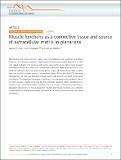| dc.contributor.author | Cote, Lauren Esther | |
| dc.contributor.author | Simental, Eric | |
| dc.contributor.author | Reddien, Peter | |
| dc.date.accessioned | 2020-07-30T01:24:42Z | |
| dc.date.available | 2020-07-30T01:24:42Z | |
| dc.date.issued | 2019-04 | |
| dc.date.submitted | 2018-11 | |
| dc.identifier.issn | 2041-1723 | |
| dc.identifier.uri | https://hdl.handle.net/1721.1/126442 | |
| dc.description.abstract | Regeneration and tissue turnover require new cell production and positional information. Planarians are flatworms capable of regenerating all body parts using a population of stem cells called neoblasts. The positional information required for tissue patterning is primarily harbored by muscle cells, which also control body contraction. Here we produce an in silico planarian matrisome and use recent whole-animal single-cell-transcriptome data to determine that muscle is a major source of extracellular matrix (ECM). No other ECM-secreting, fibroblast-like cell type was detected. Instead, muscle cells express core ECM components, including all 19 collagen-encoding genes. Inhibition of muscle-expressed hemicentin-1 (hmcn-1), which encodes a highly conserved ECM glycoprotein, results in ectopic peripheral localization of cells, including neoblasts, outside of the muscle layer. ECM secretion and hmcn-1-dependent maintenance of tissue separation indicate that muscle functions as a planarian connective tissue, raising the possibility of broad roles for connective tissue in adult positional information. | en_US |
| dc.language.iso | en | |
| dc.publisher | Springer Science and Business Media LLC | en_US |
| dc.relation.isversionof | http://dx.doi.org/10.1038/s41467-019-09539-6 | en_US |
| dc.rights | Creative Commons Attribution 4.0 International license | en_US |
| dc.rights.uri | https://creativecommons.org/licenses/by/4.0/ | en_US |
| dc.source | Nature | en_US |
| dc.title | Muscle functions as a connective tissue and source of extracellular matrix in planarians | en_US |
| dc.type | Article | en_US |
| dc.identifier.citation | Cote, Lauren E. et al. "Muscle functions as a connective tissue and source of extracellular matrix in planarians." Nature Communications 10 (April 2019): 1592 © 2019 The Author(s) | en_US |
| dc.contributor.department | Massachusetts Institute of Technology. Department of Biology | en_US |
| dc.relation.journal | Nature Communications | en_US |
| dc.eprint.version | Final published version | en_US |
| dc.type.uri | http://purl.org/eprint/type/JournalArticle | en_US |
| eprint.status | http://purl.org/eprint/status/PeerReviewed | en_US |
| dc.date.updated | 2019-07-18T14:28:23Z | |
| dspace.date.submission | 2019-07-18T14:28:24Z | |
| mit.journal.volume | 10 | en_US |
| mit.journal.issue | 1 | en_US |
| mit.metadata.status | Complete | |
